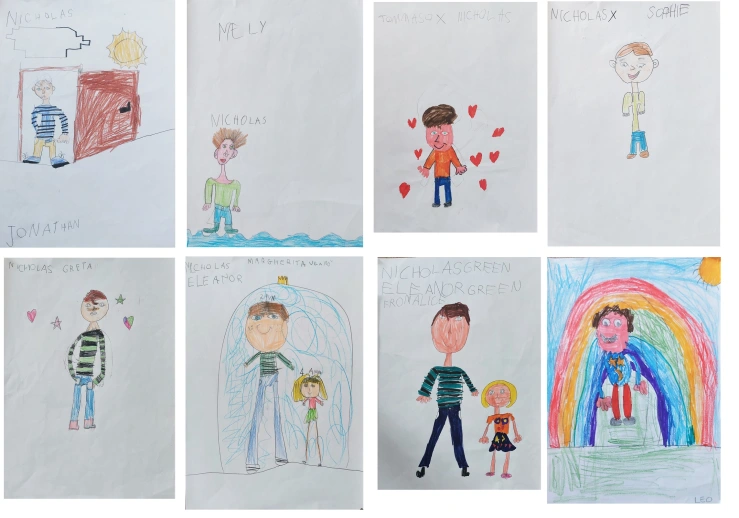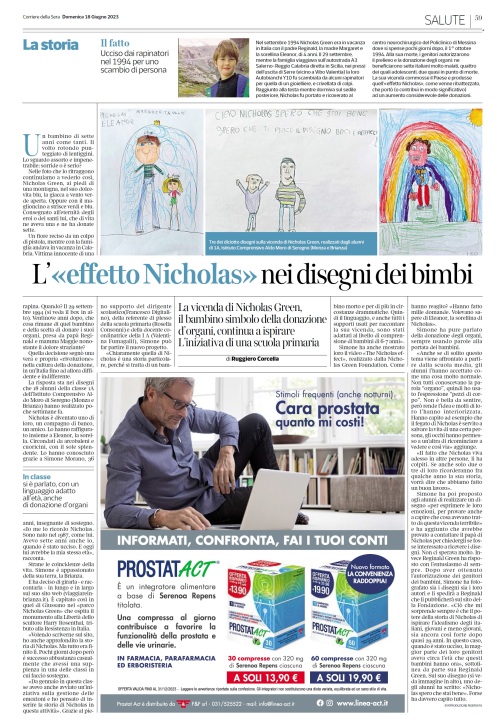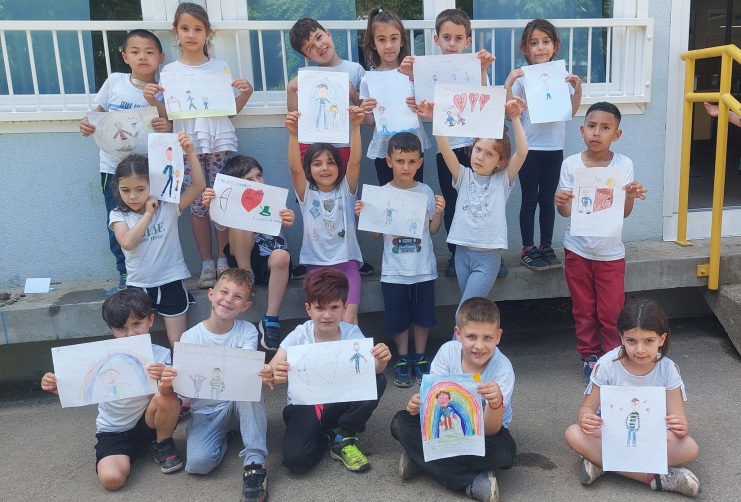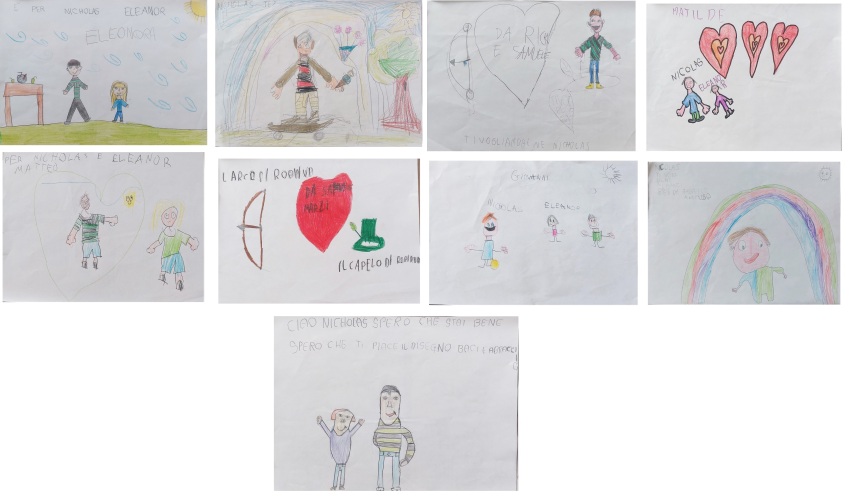One day recently this email arrived from a stranger:
“Hello,
My name is Simone and I’m Italian. I am a teacher in a primary school near Milan. Last Thursday I told Nicholas’ story to my students. They are 7 years old, the same age Nicholas was when he came to Italy. I showed them the “Nicholas Effect” video and many pictures of Nicholas. I explained to them that Nicholas is now a new friend of them. Nicholas is a very special friend, because he is their age (7) but he is also my age: I was born in 1987, too. The children have made me understand that they already love Nicholas. Every child has created a drawing to honor Nicholas’ memory. I would be happy to photograph the drawings and send them to you via email. Do you think this could be possible? Thank you for your attention……………
Sincerely, Simone and his students”
I sent the email to Ruggiero Corcella, senior editor at Corriere della Sera, Italy’s largest daily newspaper, because of the powerful pieces he has written about organ donation. The result was this heart-warming article in the print edition of June 18:
Translation:
A seven-year-old boy like many others. The round face dotted with freckles. The absorbed and impenetrable gaze: is he smiling or is he serious? In the photos that portray him, we continue to see him, Nicholas Green, like that, at the foot of a mountain, in his blue turtleneck, the green windbreaker open. Or in a green and blue striped sweater. Passed down to the eternity of heroes or saints, he who had one life and donated seven. A flower cut by a shot from a gun, while he was on vacation in Calabria with his family. Innocent victim of a robbery.
When? On September 29, 1994. Twenty-nine years later, what endures of that child and the choice to donate his own organs, made by his dad Reginald and his mom Maggie through excruciating pain? That decision marked a real “revolution” in the culture of giving, in an Italy until then suspicious and indifferent. The answer lies in the drawings that … pupils of class 1A of the Aldo Moro primary school of Seregno made a few weeks ago. Nicholas became one of them, a classmate, a friend. They depicted it together with Eleanor, his sister. Surrounded by rainbows and little hearts, with the shining sun. They came to know him thanks to Simone Morano, 36 years old, a teacher’s aid.
“I remember about Nicholas. I was born in 1987, like him. I was seven years old too, when he was killed. And today he would be my same age”, he says. Strange coincidences of life. Simone loves his part of Italy, Brianza, and he decided to travel to all of it – far and wide on his website (www.viaggiareinbrianza.it). He ended up in Giussano, in the “Nicholas Green Park” which hosts the ‘Monument to Freedom’ made by sculptor Harry Rosenthal, a tribute to the Resistance in Italy. “Wanting to write about it on the site, I also delved into the story of Nicholas. And that was all. A few days later, by accident it happened that I had a substitute teaching assignment in one of the classes where I assist. Last January, in this class I also started an initiative on the management of emotions and thought to insert the story of Nicholas in this activity”.
Thanks to the support of the school principal (Francesco Digitalino), the school complex manager for the primary school (Rosella Consonni) and the coordinator of the 1A class (Valentina Fumagalli), Simone was able to start the new project. “Clearly Nicholas’ is a special story because it talks of a child who died and moreover who did so under dramatic circumstances. So, the language and all the ways used to tell his story have been adapted to the level of understanding of 6-7 year-old children”. Simone also showed them the «The Nicholas effect» video made by the Nicholas Green Foundation.
 How did they react? “They asked a thousand questions. They wanted to know about Eleanor, the little sister of Nicholas.” Simone also spoke of organ donation, always using words suitable for children. “Although this topic (of organ donation) is approached with students from middle school, these pupils accepted it as a very normal thing. Not everyone knew the word “organ”, so I used the expression “parts of the body”. It is not a nice expression to hear, but it conveys the idea, and many children absorbed it. They understood, for example, that Nicholas’ liver saved the life of a certain person, his eyes allowed another person to start seeing again and so on» he adds. “The fact that Nicholas lives now in other people has affected them. If even only two or three of them will remember his story in a few years from now, it means that we did a good job”.
How did they react? “They asked a thousand questions. They wanted to know about Eleanor, the little sister of Nicholas.” Simone also spoke of organ donation, always using words suitable for children. “Although this topic (of organ donation) is approached with students from middle school, these pupils accepted it as a very normal thing. Not everyone knew the word “organ”, so I used the expression “parts of the body”. It is not a nice expression to hear, but it conveys the idea, and many children absorbed it. They understood, for example, that Nicholas’ liver saved the life of a certain person, his eyes allowed another person to start seeing again and so on» he adds. “The fact that Nicholas lives now in other people has affected them. If even only two or three of them will remember his story in a few years from now, it means that we did a good job”.
Simone then suggested that his students should draw a picture “to express their emotions, and to try to understand what they had learnt from this terrible event” and he added that he wondered if he should contact Nicholas’ dad to ask him if he was interested in receiving the drawings. He did not have high hopes. Instead, Reginald Green replied with his usual enthusiasm. After obtaining permission from the parents of the children, Simone photographed both the drawings and their authors, and will send everything to Reginald to be published on the website of the Foundation. “What I always find surprising is that the power of Nicholas’ story to inspire the idealism of Italians, young and old, is still so strong after almost 29 years. In this case, when Nicholas was killed, most parents of these children were about the age these children are now,” Reginald Green emphasizes.
On his drawing, one of the pupils wrote: “Nicholas I hope you’re fine”. Perhaps he really understood everything.





